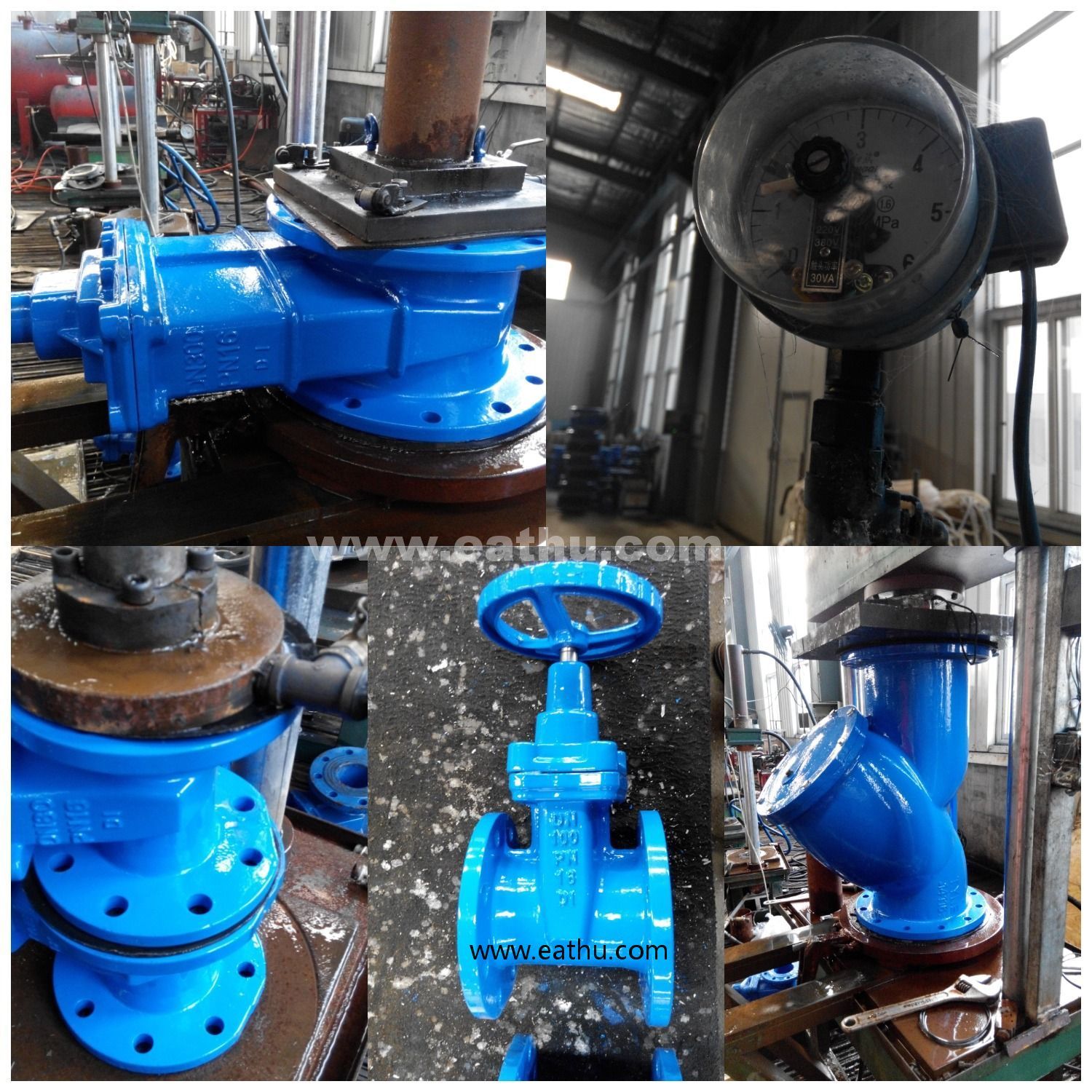Export Office: 21Floor, No.5 Nanhai Zhi Road,Qingdao, Shandong ,China
Work Shop: Beian Industrial zone, Qingdao,Shandong,China
+86 532 88550858
Martin
Inquiry now
I. Leakage of body and bonnet
► reasons:
1. Casting quality of cast iron parts is not high, valve body and bonnet with sand holes, loose organization, slag and other defects;
2. Cold wheather caused cracking;
3. Poor welding, slag inclusion, non-welding, stress cracks and other defects;
4. The cast iron valve was damaged after being hit by heavy objects.
► maintenance methods:
1. To improve the quality of casting, and to conduct strength tests in strict accordance with regulations before installation;
2. When temperatures ≤ 0℃,heat preservation or mixing shall be carried out for the valves, and the valves that stop use shall remove stagnant water;
3. Welds of welded body and bonnet shall be carried out in accordance with the relevant welding procedures, followed by flaw detection and strength tests;
4. It is forbidden to load heavy objects on the valves. It is not allowed to impact cast iron and non-metallic valves with hand hammers. Large size valves should be installed with supports.
► valve body leakage specific treatment method:
1. Bonding
By using the characteristics of fast curing speed of adhesive, the adhesive is coated near the pin in time, and a new solid sealing structure is set up to achieve the purpose of stopping leakage. It is a method of pressure plugging by using the special function of adhesive.
For the sand hole with small medium pressure and small leakage amount, polish near the leakage point first until it turns to be metal gloss , and then use a taper pin to nail into the leakage point.
During operation, the top pressure mechanism is fixed on one side of the regulating valve, and the high speed top pressure screw makes the axial alignment of the top pressure screw to the leakage point, rotates the top pressure screw, and uses the rivets at the end of the top pressure screw to firmly press on the leakage site. Force leakage to rest.
2. Welding
A) when the leakage medium pressure of the valve body is low and the leakage amount is small, a nut with an inner diameter more than twice the leakage point can be used to let the leakage medium flow out of the nut, weld the nut to the valve body, and place a rubber pad or asbestos pad at the bottom of the nut. Screw the top of the bolt around the tape into the nut to prevent leakage.
For the valve body with high medium pressure and large leakage, drainage welding method can be used. First, with an iron plate with a round hole in the middle, a isolating valve corresponding to the round hole is welded to the round hole of the iron plate, the isolating valve is opened, and the central hole of the iron plate is aligned with the leakage point in the valve body. Let leakage medium flow through the central hole of iron plate and isolation valve.
B) The leakage medium in the valve body is high temperature and high pressure, but the adjustment valve has a large shape and size, and the leakage amount is small, leakage can also be welded.
First, weld all the the gap related to the leakage point on the valve body (without the leakage point), then prepare a pipe with a normal length of 200mm(depending on the field environment) which fit the working condition.and it’s ID should be larger than the leakage point.Welding a regulating valve fit to the pipe on one end of the pipe, and fully open the regulating valve, and then weld the other end of the pipe to the leakage point , closing the regulating valve can stop the leakage.
If the bonding surface is not good, rubber or asbestos pad can be placed on the bonding surface, and then welded with the valve body near the iron plate.
II. Leak at packing
Valve leakage, leaking at the packing is most common.
► reasons:
1. Improper packing selection, not resistant to medium corrosion, high pressure valve or vacuum, high or low temperature use;
2. Packing installation is wrong, there are small generation of large, spiral winding joint bad, up is tight and bottom is loose and other defects;
3.Packings are aged and lose elasticity beyond their useful life;
4.Stem accuracy is not high, bending, corrosion, wear and other defects;
5. The number of packing rings is insufficient and the gland is not compacted;
6. Damages of the gland, bolts, and other components that prevent the gland from pressing;
7. Improper operation, excessive force, etc;
8. The gland is skewed and the gap between the gland and the stem is too small or too large, resulting in wear of the stem and damage to the packing.
► maintenance methods:
1. Materials and types of packing should be selected according to working conditions;
The packing shall be installed correctly according to the relevant regulations, and the root of the plate shall be pressed in circles;
3. Packing used too long time, aged and damaged should be replaced in time;
4. Stem bending, w ear should be straight, repair, serious damage should be replaced in time;
5. The packing shall be installed according to the specified number of rings, the gland shall be symmetrically and evenly tightened, and the jacket shall have a pre-tightening gap of more than 5 mm;
6. Damaged glands, bolts and other components shall be repaired or replaced in a timely manner;
7. Operating procedures shall be followed, operating at a constant normal force, except for the impact handwheel;
8. Gland bolts shall be tightened evenly and symmetrically, and the gap between the gland and the stem shall be properly increased if it is too small;if the gap between the cover and the stem is too big, shall be replaced.
III. Leakage of sealing surfaces
► reasons:
1. Seal surface grinding uneven, can not form a closed seal surface;
2. The top core of the connection between the stem and the closure is suspended, incorrect or worn;
3. The stem is bent or misassembled so that the closure is skewed or misaligned;
4. The quality of sealing surface material is not selected properly or the valve is not selected according to the working condition.
► maintenance methods:
1. Proper selection of materials and types of seals according to working conditions;
2. Bolts should be evenly and symmetrically twisted, torsion wrenches should be used if necessary, pretightening force should meet the requirements, not too large or small. There should be pre-tightening clearance between flange and thread joint;
3. Gasket assembly should be in the right, uniform force, gaskets are not allowed to lap and use double pads;
4. Sealing surface corrosion, damage processing, processing quality is not high, should be repaired, grinding, coloring inspection, to make the sealing surface to meet the relevant requirements;
Pay attention to cleaning when installing the gasket, the sealing surface should be cleared with kerosene, and the gasket should not fall to the ground.
IV. Leak at the connection of the sealing ring
► reasons:
1. Seal ring rolling is not strict;
2. Seal ring and body welding, surfacing welding quality is poor;
3. Sealing ring connecting thread, screw, pressure ring loose;
4. The sealing ring is connected but corroded.
► maintenance methods:
1. Leakage at seal rolling place should be fixed by glue injection ;
2. The sealing ring shall be rewelded according to the welding specification. When the surfacing can not be repaired, the original surfacing and processing should be removed;
3. Remove screws, press ring cleaning, replace damaged parts, grind seal and joint face, reassemble. The parts with large corrosion damage can be repaired by welding and bonding;
4. Sealing ring connection surface is corroded, can be ground, bonding and other methods to repair, replacement when it can not be repaired.
V. Leakage due to shedding of closures
► reasons:
1. Poor operation, so that the closure stuck or over the top dead point, joint damage and fracture;
2. The closure is not firmly connected and loose and falls off;
3. The material of the connector is not correct and can not withstand the corrosion of the medium and mechanical wear.
► maintenance methods:
1. Correct operation, when closing the valve can not force too much, opening the valve can not exceed the upper dead point, after the valve is fully open, the handwheel should be reversed a little;
2. The closure shall be firmly connected to the stem, and the threaded connection shall be retractable;
3. Fasteners for connecting shutters to stem shall withstand corrosion of the medium and have a certain mechanical strength and wear resistance.
For more information and technical support please visit:www.eathu.com
We can supply high quality valves ,reference to the follow site:
https://www.eathu.com/product/eathu-valves.html

Export Office: 21Floor, No.5 Nanhai Zhi Road,Qingdao, Shandong ,China
Work Shop: Beian Industrial zone, Qingdao,Shandong,China
+86 532 88550858
Martin
© 2020 Qingdao Fluido Industrial Co.,Ltd. All Rights Reserved. Qingdao fluido valve

